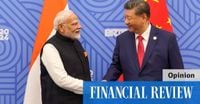In the swirling currents of global trade and diplomacy, the summer of 2025 stands out as a moment of dramatic recalibration. From Washington to New Delhi, and from Taipei to Moscow, the United States’ aggressive use of tariffs and its shifting signals on security alliances have forced allies and adversaries alike to rethink their strategies and allegiances. The Trump administration’s recent moves—especially its high-profile tariff hikes and the subtle sidelining of key Taiwanese visits—have sent ripples through international markets and diplomatic circles, leaving many to wonder: is this a new normal, or just another round in the ongoing game of geopolitical brinkmanship?
The latest chapter began in mid-July, when Taiwanese President Lai Ching-te’s planned stopover in New York was abruptly postponed. According to reporting from multiple sources, this move came after Beijing’s immediate protests and just as U.S. and Chinese officials were preparing for a crucial third round of trade talks in Stockholm. At the same time, the Trump administration quietly advised Taiwan’s Defense Minister, Wellington Koo, to hold off on his scheduled visit to Washington, D.C.—again, a gesture widely interpreted as an attempt to create a more favorable environment for a potential summit between President Donald Trump and China’s President Xi Jinping.
This wasn’t the administration’s first foray into using Taiwan as a diplomatic bargaining chip. As The Economist notes, back in 2019, the White House delayed a fighter jet sale to Taipei in a similar bid to improve the prospects for a trade deal with China. That effort ultimately fizzled, and tariffs soon soared again. Yet by the end of Trump’s first term, he had approved more arms sales to Taiwan by value than any of his predecessors since 1990. This history suggests that these latest gestures—postponing visits and cooling public displays of support—are likely tactical, not strategic. As one American official put it, “For Trump, flexibility on Taiwan remains a bargaining instrument that can be dialed up or down depending on the state of negotiations.”
Indeed, Trump has largely stuck to the U.S. policy of "strategic ambiguity" regarding Taiwan. When asked in February whether the United States would defend the island militarily, he demurred: “I never comment on that.” Even before taking office, he’d framed his approach with similar vagueness: “I never say… I have to negotiate things, right?” This deliberate ambiguity has long been a hallmark of U.S. policy, keeping options open and avoiding any pre-commitment to a specific response if Beijing were to move against Taiwan.
But while Trump himself keeps the message murky, his senior Cabinet officials have sometimes drawn a firmer line. Secretary of State Marco Rubio declared in July, “We remain as committed as ever to our partners… in places like Taiwan.” Defense Secretary Pete Hegseth was even more blunt at the May Shangri-La Dialogue, warning about the Chinese military’s threat to Taiwan and the urgent need for military preparedness. Actions have backed up these words: in June, senior Taiwanese officers were invited to observe a U.S.-led multilateral air exercise in Alaska, and U.S. naval ships transited the Taiwan Strait in both February and April—clear signals of ongoing deterrence and reassurance.
Yet the White House is hardly the only player shaping U.S. policy toward Taiwan. Congress has long set the guardrails, grounded in the Taiwan Relations Act, to uphold American commitments to the island. The saga of Lee Teng-hui’s 1994-95 visits to the U.S. is a classic example: congressional pressure forced the Clinton administration to relax transit restrictions, and a near-unanimous House resolution ultimately led to a presidential reversal. Congressional support has only grown stronger in recent years. From 2017 to 2023, lawmakers introduced 124 Taiwan-related bills—double the tally from the previous eight years. Congressional delegations have also shifted their focus: while trips to Beijing outnumbered visits to Taipei before 2020, the flow has now reversed. This August, a delegation led by Senator Roger Wicker, chair of the Senate Armed Services Committee and a longtime Taiwan advocate, is set to visit Taipei, underscoring enduring bipartisan commitment.
Meanwhile, the Trump administration’s approach to trade has been no less disruptive. Since his inauguration, tariffs have been wielded as both an economic and political weapon, impacting not just China but also countries like India, Brazil, and Canada. As The Economist observes, this has left both allies and adversaries uncertain about where they stand. The American commentariat—conservative and liberal alike—has voiced strong criticism, arguing that these tariff policies are not always in the nation’s best interest. But the administration has pressed on, undeterred by domestic dissent.
Nowhere is the fallout more visible than in India. In 2025, the Trump administration imposed a punishing 50% tariff on Indian exports, citing New Delhi’s continued purchases of Russian oil. This move has hit India’s export-driven sectors—textiles, carpets, aquaculture—especially hard. In Bhadohi, the country’s carpet-making hub, 2.5 million workers now face the grim prospect of subsistence-level poverty as U.S. demand for Indian goods collapses. Yet India has responded with a blend of pragmatism and defiance. Prime Minister Narendra Modi’s “Make in India” initiative has accelerated, aiming to reduce the country’s reliance on exports and build up domestic manufacturing muscle.
At the same time, India has doubled down on its energy and defense ties with Russia. By mid-2025, it was importing 1.6 million barrels of Russian oil daily, second only to China. This pivot isn’t just about cheap oil; it’s a strategic play to bypass U.S. dollar-dominated trade routes and position India as a linchpin in a more multipolar energy order. On the defense front, India’s reliance on Russian hardware—such as the S-400 missile system—has only grown, even as the U.S. responds with secondary sanctions. The Indian defense sector, now a $100 billion market, is attracting investment from Israel, France, and other non-U.S. players, reducing its exposure to American policy swings.
These realignments have far-reaching implications. The U.S.-India trade dispute is reshaping regional alliances, with India strengthening its partnerships in the Quadrilateral Security Dialogue (the Quad) alongside Japan, Australia, and the U.S.—though not without growing skepticism. At the same time, India is cautiously engaging with China through forums like the Shanghai Cooperation Organization, seeking to avoid a full-blown trade war while hedging its bets.
For investors and policymakers alike, the message is clear: the world of 2025 is one of profound uncertainty and shifting allegiances. Commodities, defense, and regional diversification are the new watchwords, as traditional alliances fray and new economic corridors emerge. The Trump administration’s weaponization of tariffs and its flexible approach to alliances may be creating short-term turbulence, but they’re also catalyzing a broader, more lasting realignment. Whether this new order brings stability or further upheaval remains to be seen—but for now, the only certainty is change.





